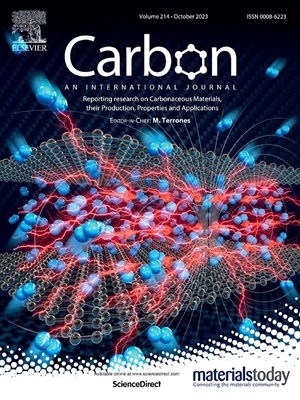High-performance phosphorus/carbon anodes with P–O–C bonds enabled by oxygen-rich CO2-Derived carbon for sodium-ion batteries
IF 10.5
2区 材料科学
Q1 CHEMISTRY, PHYSICAL
引用次数: 0
Abstract
Red phosphorus (RP) is a promising anode material for sodium-ion batteries (SIBs) due to its high theoretical capacity and cost-effectiveness. However, its practical use is constrained by poor electronic conductivity and severe volume expansion during cycling. Herein, we introduce a new strategy to synthesize phosphorus/carbon (P/C) composites enriched with phosphorus-oxygen-carbon (P–O–C) bonds, achieved by high-energy ball milling of CO2-derived oxygen-rich electrolytic carbon (EC) with RP. This approach enhances the conductivity and structural stability of RP while effectively mitigating volume changes during charge-discharge cycles. Electrochemical evaluation reveals that the P/EC composite exhibits outstanding performance, maintaining a high capacity of 871.6 mAh g−1 after 200 cycles at 0.26 A g−1 with a retention rate of 88.6 %, and delivering 340.2 mAh g−1 after 2000 cycles at 2.6 A g−1. This work demonstrates the potential of integrating CO2-derived EC with RP to create advanced anode materials with enhanced stability and high-rate capability, paving the way for next-generation SIBs.

具有P-O-C键的高性能磷/碳阳极,由富氧二氧化碳衍生碳实现,用于钠离子电池
红磷具有较高的理论容量和成本效益,是一种很有前途的钠离子电池负极材料。然而,它的实际应用受到电子导电性差和循环过程中严重的体积膨胀的限制。本文介绍了一种利用RP对co2衍生的富氧电解碳(EC)进行高能球磨,合成富磷-氧-碳(P -o - C)键的磷/碳(P/C)复合材料的新策略。这种方法提高了RP的导电性和结构稳定性,同时有效地减轻了充放电循环过程中的体积变化。电化学评价表明,P/EC复合材料表现出优异的性能,在0.26 a g−1下循环200次后仍能保持871.6 mAh g−1的高容量,保留率为88.6%,在2.6 a g−1下循环2000次后仍能提供340.2 mAh g−1。这项工作证明了将二氧化碳衍生的EC与RP集成在一起的潜力,可以创造出具有更高稳定性和高速率能力的先进阳极材料,为下一代sib铺平道路。
本文章由计算机程序翻译,如有差异,请以英文原文为准。
求助全文
约1分钟内获得全文
求助全文
来源期刊

Carbon
工程技术-材料科学:综合
CiteScore
20.80
自引率
7.30%
发文量
0
审稿时长
23 days
期刊介绍:
The journal Carbon is an international multidisciplinary forum for communicating scientific advances in the field of carbon materials. It reports new findings related to the formation, structure, properties, behaviors, and technological applications of carbons. Carbons are a broad class of ordered or disordered solid phases composed primarily of elemental carbon, including but not limited to carbon black, carbon fibers and filaments, carbon nanotubes, diamond and diamond-like carbon, fullerenes, glassy carbon, graphite, graphene, graphene-oxide, porous carbons, pyrolytic carbon, and other sp2 and non-sp2 hybridized carbon systems. Carbon is the companion title to the open access journal Carbon Trends. Relevant application areas for carbon materials include biology and medicine, catalysis, electronic, optoelectronic, spintronic, high-frequency, and photonic devices, energy storage and conversion systems, environmental applications and water treatment, smart materials and systems, and structural and thermal applications.
 求助内容:
求助内容: 应助结果提醒方式:
应助结果提醒方式:


